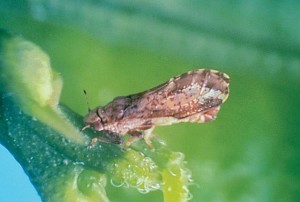HLB Detected in California’s Historic Home of Citrus
According to the California Citrus Pest & Disease Prevention Program, state and federal officials recently confirmed the presence in Riverside County, the state’s historic home of citrus, of Huanglongbing (HLB), also known as citrus greening, a deadly disease for citrus plants that can be transmitted from tree to tree by the Asian citrus psyllid (ACP).
The California Department of Food and Agriculture (CDFA) and the USDA confirmed the HLB find. The disease was detected in a CDFA sample collected July 10 from a grapefruit tree in a residential neighborhood in the city of Riverside. The disease devastates citrus and closely related species.
In cooperation with the Riverside County Agricultural Commissioner’s Office and USDA, CDFA has begun an extensive survey and treatment program. Crews will remove and dispose of the infected tree and are preparing to treat citrus trees within 800 feet for ACP infestations. Taking these steps will remove a critical reservoir of the disease and vectors that can spread the disease, an essential tactic in protecting nearby citrus.
The find does not immediately affect the state’s major commercial citrus production areas. However, Riverside has a storied history of citrus production and is home to California Citrus State Historic Park, which preserves the cultural landscape of the citrus industry and tells the story of the industry’s role in the history and development of California. Though not affected by this HLB quarantine, the historic park and all citrus throughout Riverside are threatened by any presence of the disease.

The Asian citrus psyllid is notorious for spreading HLB.
The ACP can spread the bacteria when the pest moves from one location to another, feeding on citrus trees and other plants by attacking their vascular systems. Once a tree is infected there is no cure and it typically declines and dies within a few years.
“The discovery of this disease means all citrus trees are at risk — including homegrown trees enjoyed by residents and thousands of acres of trees cared-for by citrus farmers,” said Ruben Arroyo, Riverside County Agricultural Commissioner/Sealer. “It’s important for residents, growers, and agricultural officials to work together to quickly find this disease and stop its spread. I encourage everyone to visit CaliforniaCitrusThreat.org to review symptoms of the disease and report disease sightings.”
A quarantine will be established in the area where HLB was detected. The quarantine prohibits the sale of all host nursery stock and the movement of all host plants and fruits within a five-mile radius of the find, and applies to residents and commercial operations alike.
CDFA, in partnership with local agricultural commissioners, USDA and the citrus industry, continues to pursue its strategy of controlling the spread of ACP while researchers work to find a cure for the disease.
HLB is known to be present in Mexico and in parts of the Southern U.S. Florida first detected the pest in 1998 and the disease in 2005. The University of Florida estimates that the disease causes an average loss of 7,513 jobs per year, and has cost growers $3 billion in lost revenue since it was first detected there. ACP was first detected in California in 2008.
Click here for more information about ACP or HLB, or call CDFA’s toll-free pest hotline at 1-800-491-1899. Riverside County residents may call the Agricultural Commissioner’s Office at (951) 955-3045.
The California Citrus Pest & Disease Prevention Program is a grower-funded program administered by the Citrus Pest & Disease Prevention Committee, which was established to advise the California Secretary of Agriculture and the agricultural industry about efforts to combat serious pests and diseases that could threaten the state’s citrus industry.









